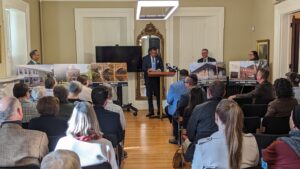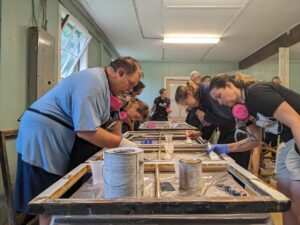“We were given access to these great modernist floors and we felt that era of architecture was better suited for what we were trying to convey emotionally.”
– Nathan Crowley, production designer for The Dark Knight
Christopher Nolan’s 2005 rebooting of the Batman movie franchise Batman Begins is set in the fictional “Gotham City” which is based on a dystopian vision of modern-day Chicago. The set design features a futuristic version of the famous elevated train and Holabird and Root’s 1930 Board of Trade Building re-imagined as the headquarters of “Wayne Enterprises.”
For the next installment of the series, 2008’s The Dark Knight, Nolan and production designer Nathan Crowley once again based Gotham’s look on “the city of big shoulders.” This time, instead of creating a highly stylized fantasy version of Chicago they decided to focus on the “second Chicago School” era of the city’s architecture which they felt best represented the “cold and vacant” feel of the world that the movie’s characters inhabit. Although many older and more recent Chicago landmarks play major parts in the movie (Old Post Office, McCormick Place, Navy Pier, the unfinished Trump Tower and the actual implosion of the Brach’s Candy Factory, portrayed as a hospital destroyed by the villainous Joker) the majority of the on location interior scenes take place in buildings designed by the late modernist master Ludwig Mies van der Rohe.
Mies’s posthumous IBM Building (1971) is the setting for multiple scenes serving as the lobby and office of the District Attorney, the office of the mayor and the police commissioner’s office.
Designed by Mies’s former student Jaques Brownson of C.F. Murphy and Associates, the Richard J. Daley Center (1965) serves as the exterior of Bruce Wayne’s corporate headquarters (Wayne Tower), while the IBM building once again is used for the interior scenes, particularly the board room of Wayne Enterprises. The difference between the two buildings used for these scenes can be seen in the closely spaced, Travertine clad perimeter columns and normal ceiling height of the board room when compared to the Daley Center, which is known for its 87 foot wide structural bays and super-tall floors that allows a building of only 31 stories to reach a height of 648 feet as well as its self – weathering Cor-Ten structural material. For reference, our XeroxTower in downtown Rochester, an office building of 30 stories, is “only” about 450 feet tall and is a typical example of the 12-15 foot average floor height found in most skyscrapers.
To create Bruce Wayne’s luxurious and isolated penthouse apartment in downtown Gotham CityOne Illinois Center (1970), the production team shot scenes in the lobby of another posthumously finished Mies building. The lobby features massive core walls/elevator banks sheathed in Mies’s favored Travertine and his famous “striped” base columns, similar in style to the Seagram Building’s, surrounded by tall glass windows.
The outside of the lobby was wrapped in “green screens” allowing the visual – effects staff to insert views from the 39th floor penthouse suite of Milton M. Schwartz & Associates’ Hotel at 71 East Wacker Drive, completed in 1960 and situated across the river from Bertrand Goldberg’s legendary complex built between 1959 and 1967, Marina City, which is seen in the background throughout the movie. The exterior shots of Wayne’s apartment resemble a one story Miesian house placed on top of a bright aluminum and blue tinted ribbon – window tower of contrasting design. This clashing of styles is similar to the visual effect of the new penthouse apartments being grafted on to the roofs of old loft buildings in New York City’s Tribeca and SOHO neighborhoods and, to a smaller degree, in Rochester.
If the (hopefully older) children in your family drag you to this highly engaging and violent summer blockbuster but you have no interest in superheroes, or the homicidal clowns they battle, you can at least keep yourself entertained playing building spotter!
I myself missed some dialogue because I was too busy trying to guess which Chicago building the scene was shot in. Enjoy!
Posted by Dan Palmer, Landmark Society volunteer and member of the Recent Past Committee






